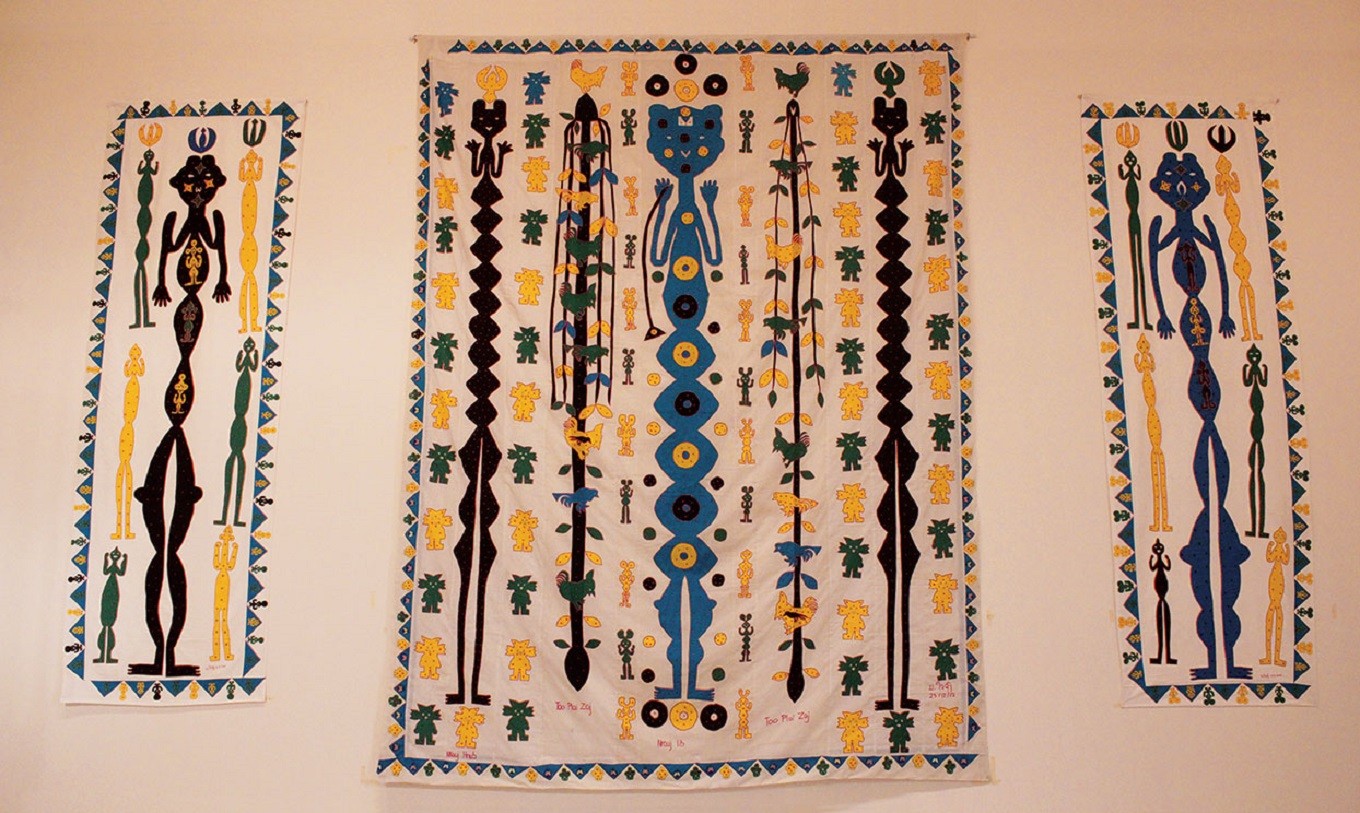Popular Reads
Top Results
Can't find what you're looking for?
View all search resultsPopular Reads
Top Results
Can't find what you're looking for?
View all search resultsAn odyssey with your future self: Singapore Art Biennale 2016
Change text size
Gift Premium Articles
to Anyone
F
rom safe and clinical Singapore, with the Zika-virus frenzy contained for now, the fifth edition of Singapore Art Biennale (SAB) 2016 entitled “An Atlas of Mirrors” presented site-specific installations, new commissions, and contemporary art works created by more than 60 artists from the nations of Southeast Asia along with Japan, China, South Korea, Taiwan, India, Pakistan, Myanmar, Sri Lanka and Bangladesh.
Slated until Feb. 26, the exhibition is shown in nine venues including Singapore Art Museum and its annex SAM 8Q, Asian Civilizations Museum and the National Museum of Singapore with nine conceptual themes touching on space and place, time and myths, memory and colonial legacy, nature, boundaries, agency, identity, migration and displacement and absence.
Susie Bingham, the creative director of SAB 2016, notes that the biennale experience begins with a simple question: "From where we are, how do we see the world?"
It offers a constellation of art works that allows one to travel through the now, the yesterday, and the tomorrows of ourselves, our identities and our places in history. As a survey of contemporary art of the region, the fifth biennale offers glimpses of the urbane confidence and complexness of art coming from even the poorest areas.
(Read also: Plot twists, suspense mark George Lucas' plans for museum)
Notably, Indonesia presents an impressive assemblage of artworks from its seven formidable artists that will linger in our memories for some time. Aside from Titarubi and Eddy Susanto, they are Ade Darmawan's Singapore Human Resources Institute, 2016, which uses discarded objects, prints, and old furniture to present an ordered space of capitalist success; Agan Harahap's Mardijker Photo Studio, 2015 that presents imagined portraits of the Mardijkers who are of mixed ancestry and descendants of Portuguese slaves who settled in Batavia; Made Djirna's Melampaui Batas/Beyond Boundaries, 2016, an installation using hundreds of terracotta figures and an old antique boat that depicts a journey between existence and eternity; Made Wianta's Treasure Islands, 2012 where he uses buffalo leather maps to trace Indonesia's "lost and forgotten islands" such as Rhun as part of its colonial past; and Melati Suryodarmo's Behind the Light, a performance-installation piece where she repetitiously presses her face on paper on top of a slab of red ink and throws away the paper.
The biennale rediscovers ancient stories and myths, traditional scripts and languages, and imbues them with 21st century aspirations. It reexamines the historical experience of colonialism that has brought havoc and destruction to the lives of ordinary people, personalized at the level of one's family.
Many artworks in SAB 2016 try to reconstruct and reimagine social and historical narratives that have been largely shaped by the dominant powers that be. They empower the dispossessed, the forgotten, and the silenced ones, as well as all those anonymous people who made a stand and sacrificed themselves against foreign invaders (the Dutch, British, and Japanese, to name a few) and brutal regimes.
The artworks also pay tribute to those displaced by politics or economics and those living on the margins of societies by attempting to reclaim their lost and forgotten voices. They may be Bangladeshi or Filipino migrant workers in Singapore or those who have lost their homes in border conflicts.
(Read also: Visiting the luxurious but not elitist Le Grand Musee du Parfum in Paris)
Some artists and their artworks that stood out:
Dislocate 2013-2015 by Bui Cong Khanh, Vietnam
A large installation of a traditional wooden Vietnamese dwelling handcrafted by the artist and his team of carpenters and woodcarvers. Entirely made of jackfruit wood, it is made of several panels with chain-linked carvings and banisters. The upper central panels contain carvings of a Vietnamese military jacket, an American GI helmet, a machine gun, a grenade, an ax, and a revolver, interspersed with motifs of lotus flowers and dragons. Four miniature pagodas on pedestals that sprout cannons with rocks, lush plants, and flowers surround the work.
Khanh draws from the craftsmanship of his ancestral province of Fujian, China and his cultural identity rooted in central Vietnam—to stress the geopolitical tensions between Vietnam and China.
 An upper panel carved with a machine gun.(JP/Rosa Connie Ladrido)
An upper panel carved with a machine gun.(JP/Rosa Connie Ladrido)
The Journey of Panji, 2016 by Eddy Susanto, Indonesia
A colored canvas scroll that contains images taken from 14th century reliefs found in the village of Gambyok, Kediri, that illustrate the Panji cycle of stories based on the exploits of the legendary Prince Panji. The stories originated from East Java and spread to what is now known as Malaysia, Cambodia, Myanmar, Thailand and the Philippines. The outlines of the images are first drawn in Javanese script, then in other scripts of the various areas and regions where the Panji cycle has spread and appropriated into the local oral tradition.
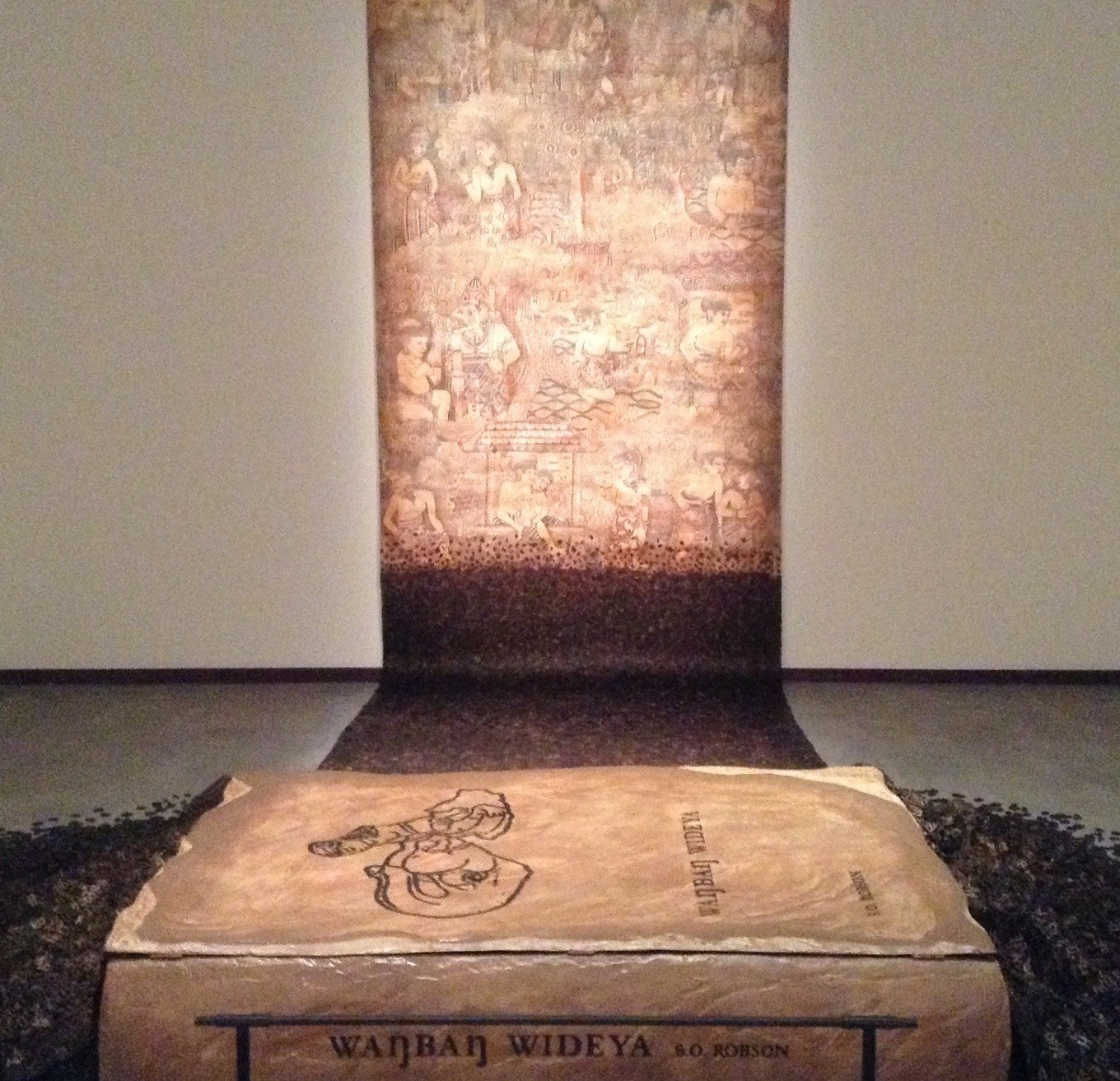 The Journey of Panji (2016) by Eddy Susanto(JP/Rosa Connie Ladrido)
The Journey of Panji (2016) by Eddy Susanto(JP/Rosa Connie Ladrido)
Attached at the end of the scroll are blackened wooden letters, all hand-sewn by out-of-school youth in Yogyakarta. The letters look like they are all falling and across the scroll, a large book installation entitled the Wangbang Wideya (1971) by S. O. Robson. It contains all the Panji stories in Latin. The letters from the scroll connect with the alphabets in Latin and in Thai, Jawi, Balinese, Khmer, Burmese and Baybayin, the ancient Philippine script, which are also spilling out of the book. It suggests that the socio-cultural diversity of societies comprising Southeast Asia is very much like a living organism that grows and transforms itself through time and space.
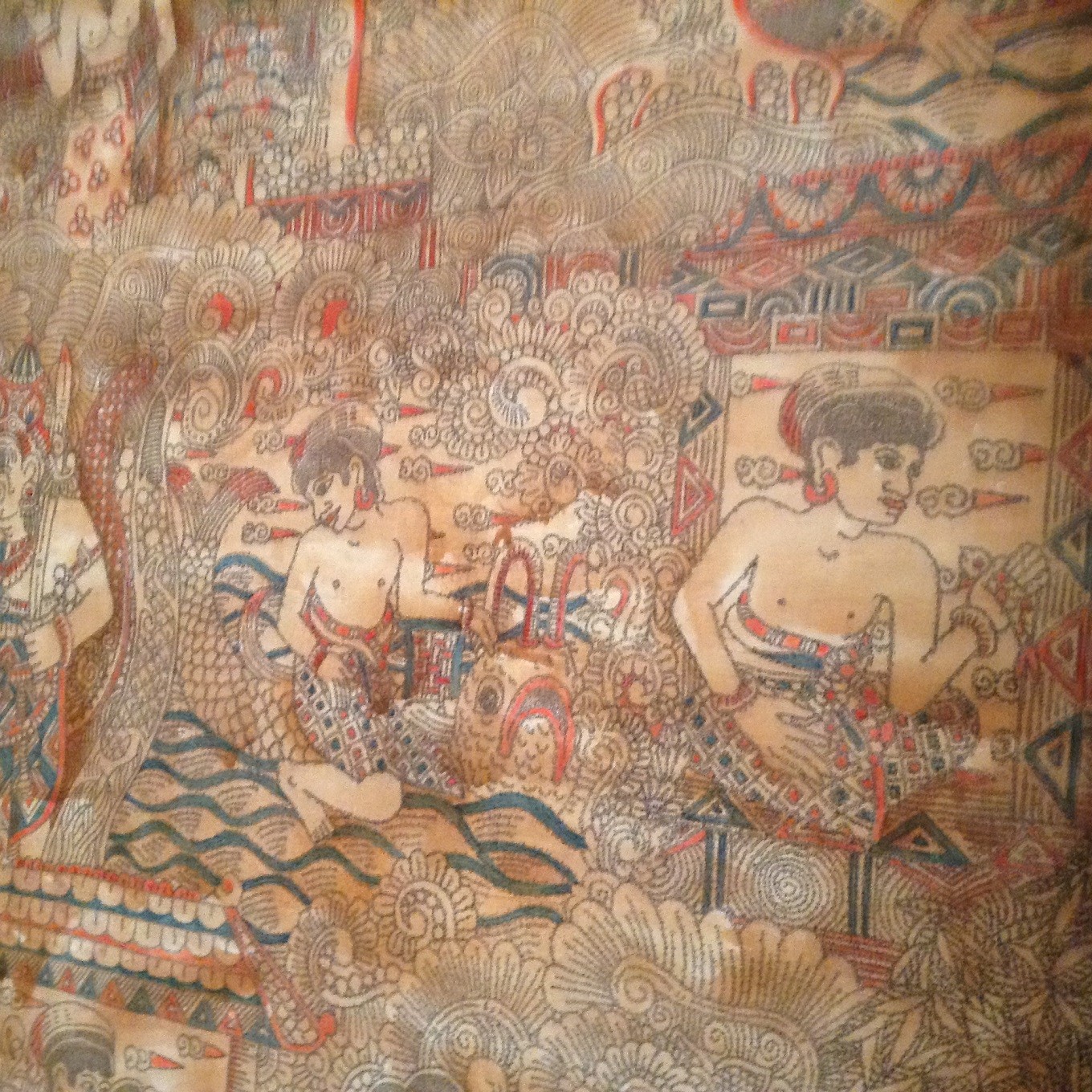 A close-up of the Panji scroll.(JP/Rosa Connie Ladrido)
A close-up of the Panji scroll.(JP/Rosa Connie Ladrido)
Aftermath, 2016 by Pannaphan Yodmanee, Thailand
A huge mural of the Buddhist cosmos done as a landscape painting where the artist presents her vision of Buddhist cosmology and the cycle of birth, life, and death.
She combines concrete and paint, rocks, roots, and materials she has picked up such as broken fragments from soon-to-be demolished temples, with her own miniature figurines of Buddhist icons to create layers of texture in her mural. Using designs and motifs of traditional Thai art with themes of loss, suffering, and devastation, she explores a turbulent world and the relevance of Buddhist philosophy in our lives.
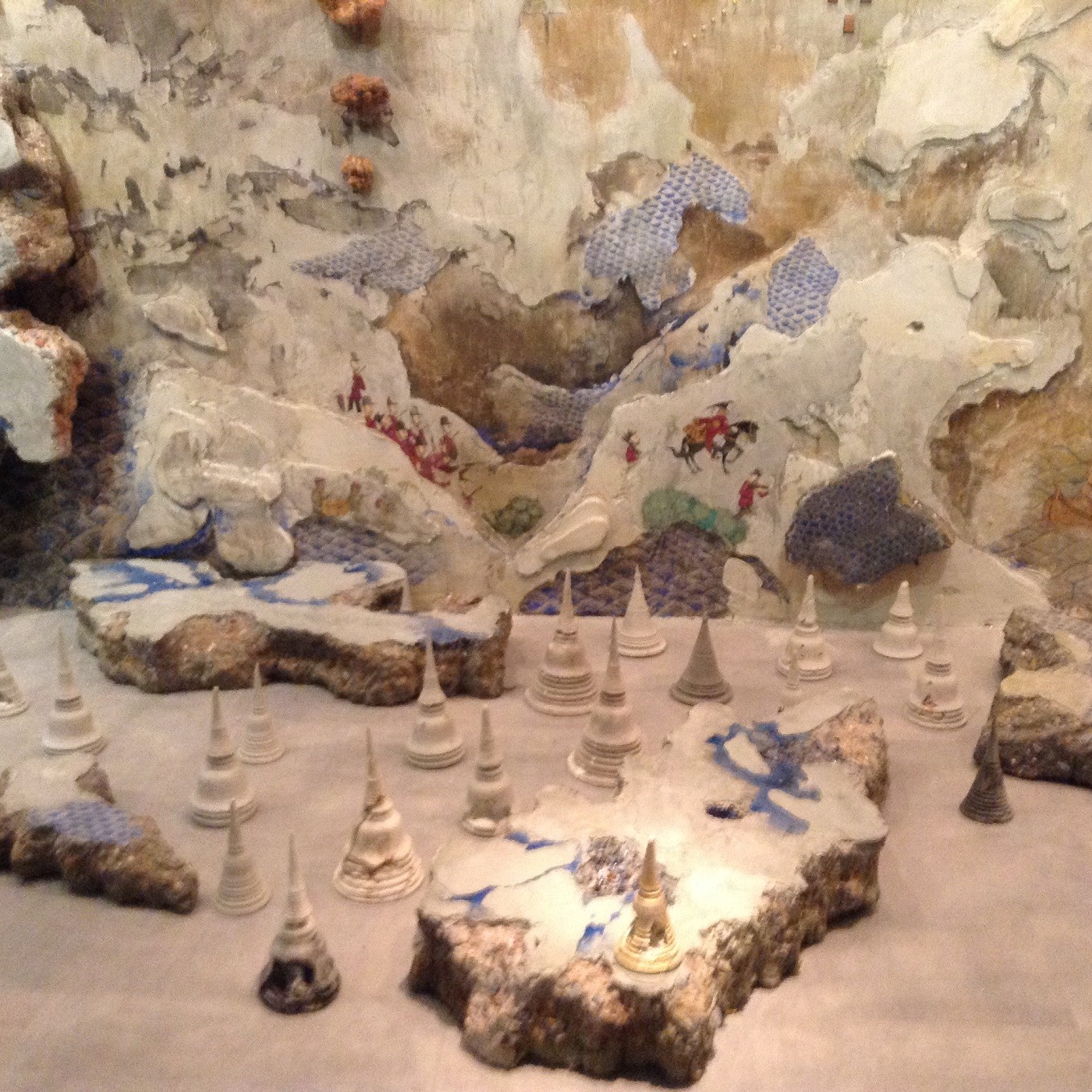 Aftermath (2016) by Pannaphan Yodmanee(JP/Rosa Connie Ladrido)
Aftermath (2016) by Pannaphan Yodmanee(JP/Rosa Connie Ladrido)
Spirit of Sky and Earth 3 & 4, 2016 and Tree Spirit, 2012 by Tcheu Siong, Laos
A refreshing change from all the techno-digital works, the traditional Hmong embroidery and "story cloths" of Laos comes alive and tactile with Siong's large-scale textile art that depicts tall and elongated figures who represent the "spirits," "souls" or "ghosts" of her dreams and visions, as interpreted by husband Phasao Lao, a village shaman.
Her artwork explores the connection between her dream world and imagination and her reality as a woman, including her demons and aspirations, all depicted in cut-up fabric, cross-stitched, and sewn into place in geometric harmony. Using appliques on cotton, Siong uses design motifs that are common in Hmong story-telling. For example, triangles that border the cloth panel represent mountains and the five circles with a dot each symbolize a peacock ocellus.
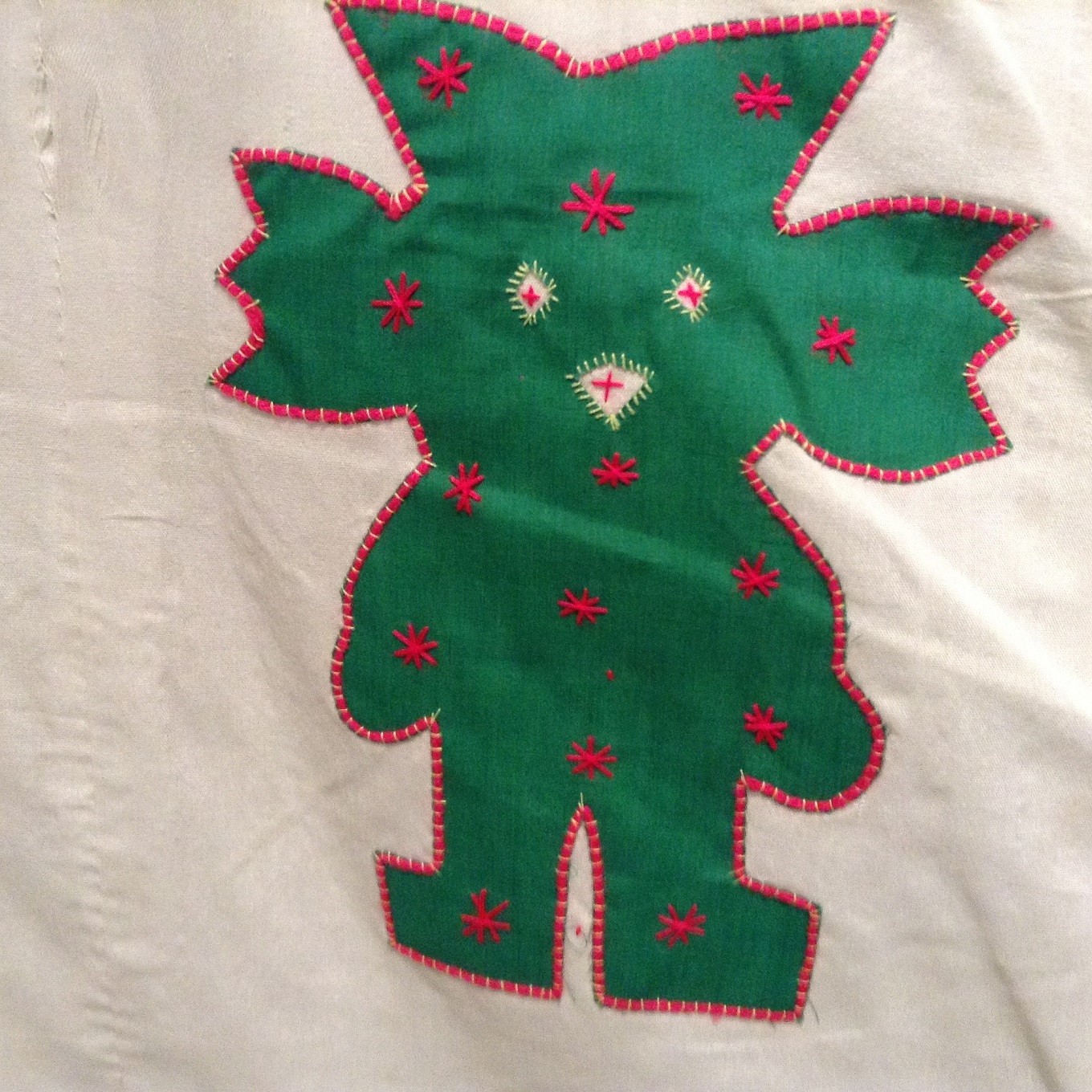 An embroidered section.(JP/Rosa Connie Ladrido)
An embroidered section.(JP/Rosa Connie Ladrido)
History Repeats Itself, 2016 by Titarubi, Indonesia
Looming large on top of charred sampans, an installation of three faceless and hooded figures with robes made of some 45,000 gold-plated nutmegs stand eerily. Inside the robes are hollow wooden bars like a cage or a prison. In Banda Islands, the only place then in the world where nutmeg was grown, nutmegs, mace, and other Indonesian spices were seen by Europeans as valuable as gold. The Bandanese were tortured and massacred and survivors became forced laborers and slaves by the Dutch. The Dutch East India Company burned Indonesian ships in order to control the spice trade. Nutmeg was a Dutch monopoly for almost 200 years.
It exhorts us to reflect on the legacies of European colonial plunder in Asia and a reminder of the loss of Indonesia's maritime power as well as Batavia's (Jakarta) status as a major trading center and port city.
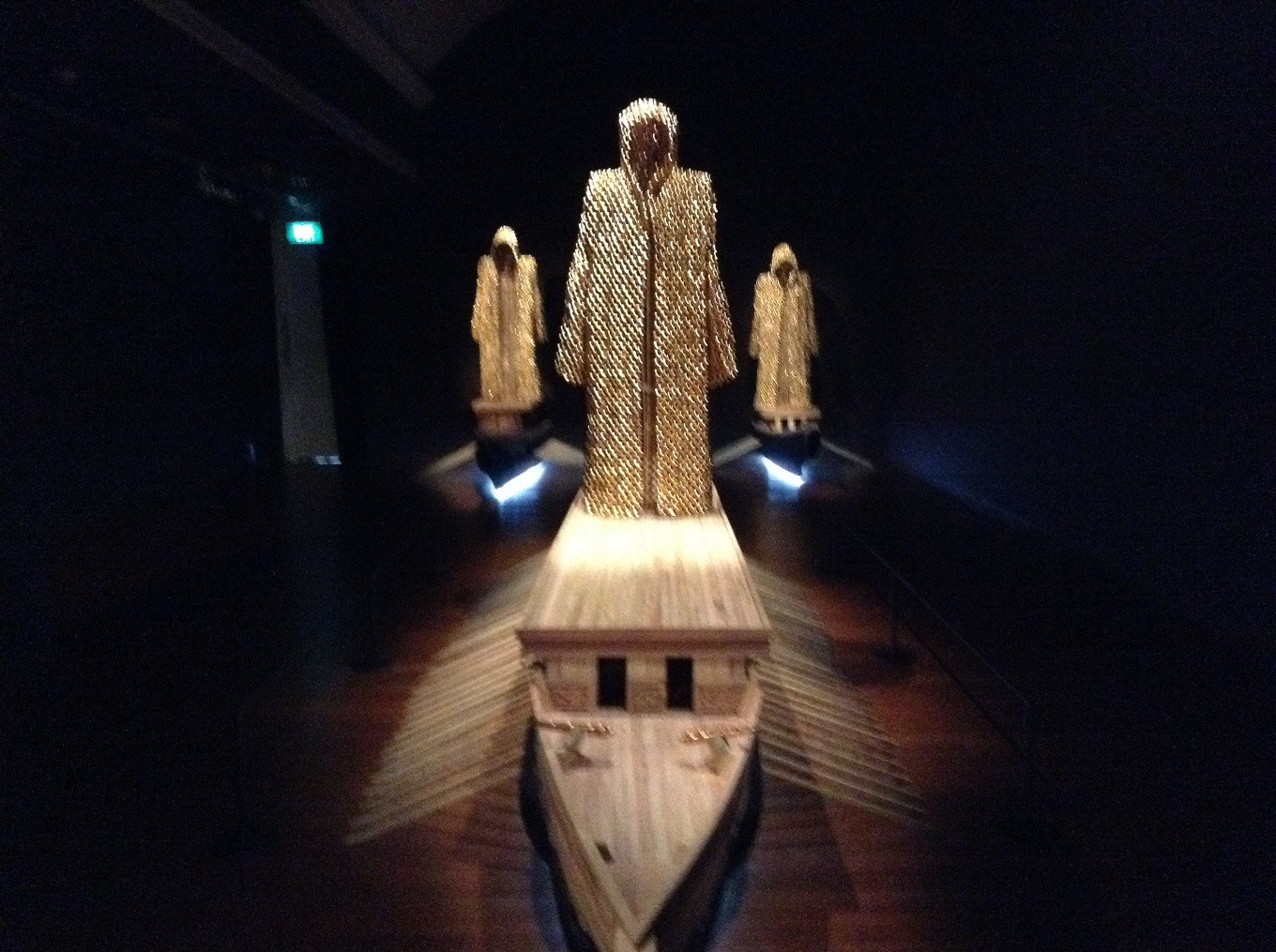 History Repeats Itself (2016) by Titarubi(JP/Rosa Connie Ladrido)
History Repeats Itself (2016) by Titarubi(JP/Rosa Connie Ladrido)
The Name, 2008-ongoing by Tun Win Aung and Wah Nu, Myanmar
This series of video projections include around 30 modified images of old photos of important individuals from Myanmar's history. Some are well-known such as King Thibaw, the last king of Burma deposed by the British; U Wisara, a Buddhist monk who died in prison after waging a six-month hunger strike against British rule in 1929 and became a martyr for Burma's independence movement; and Saya San, the leader of the Saya San Rebellion in 1930-1932. Many others were considered as "thugs, thieves and robbers" by the British colonial authorities.
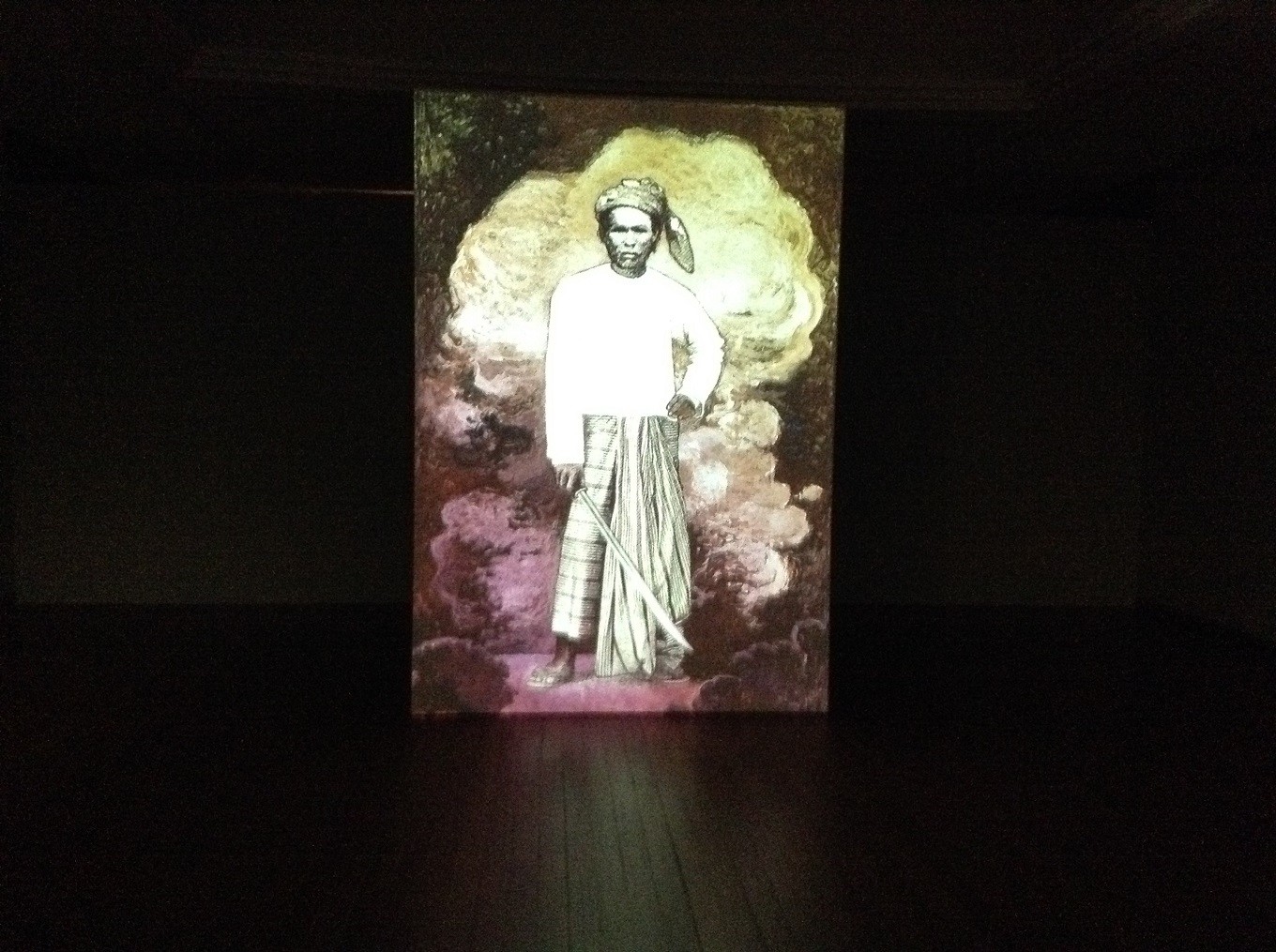 The Name (2008-ongoing) by Tun Win Aung(JP/Rosa Connie Ladrido)
The Name (2008-ongoing) by Tun Win Aung(JP/Rosa Connie Ladrido)
It revisits Myanmar's colonial narrative and extols its nameless and ordinary patriots whose voices and actions defended the Burmese nation in the 19th century Anglo-Burmese Wars. A soft chanting of their names amidst the playing of traditional musical instruments of Myanmar accompanies the visual images. The husband-and-wife collaboration embellishes the close-up faces with full and ornate regalia, floating like ethereal apparitions, intentionally idealized and represented as majestic and stately figures.
SONICreflection, 2016 by Zulkifle Mahmod, Singapore
We see colors; we hear sounds. A sound installation made of recordings from the various migrant communities in Singapore, with the help of tweeters and pencil microphones placed on a wall lined with wok lids. Each "sonic territory" emits its own soundscape, says this sound-media artist. A babel of conversation, laughter, chatter, and whispers ensue amidst other incidental noise of an urban public space.
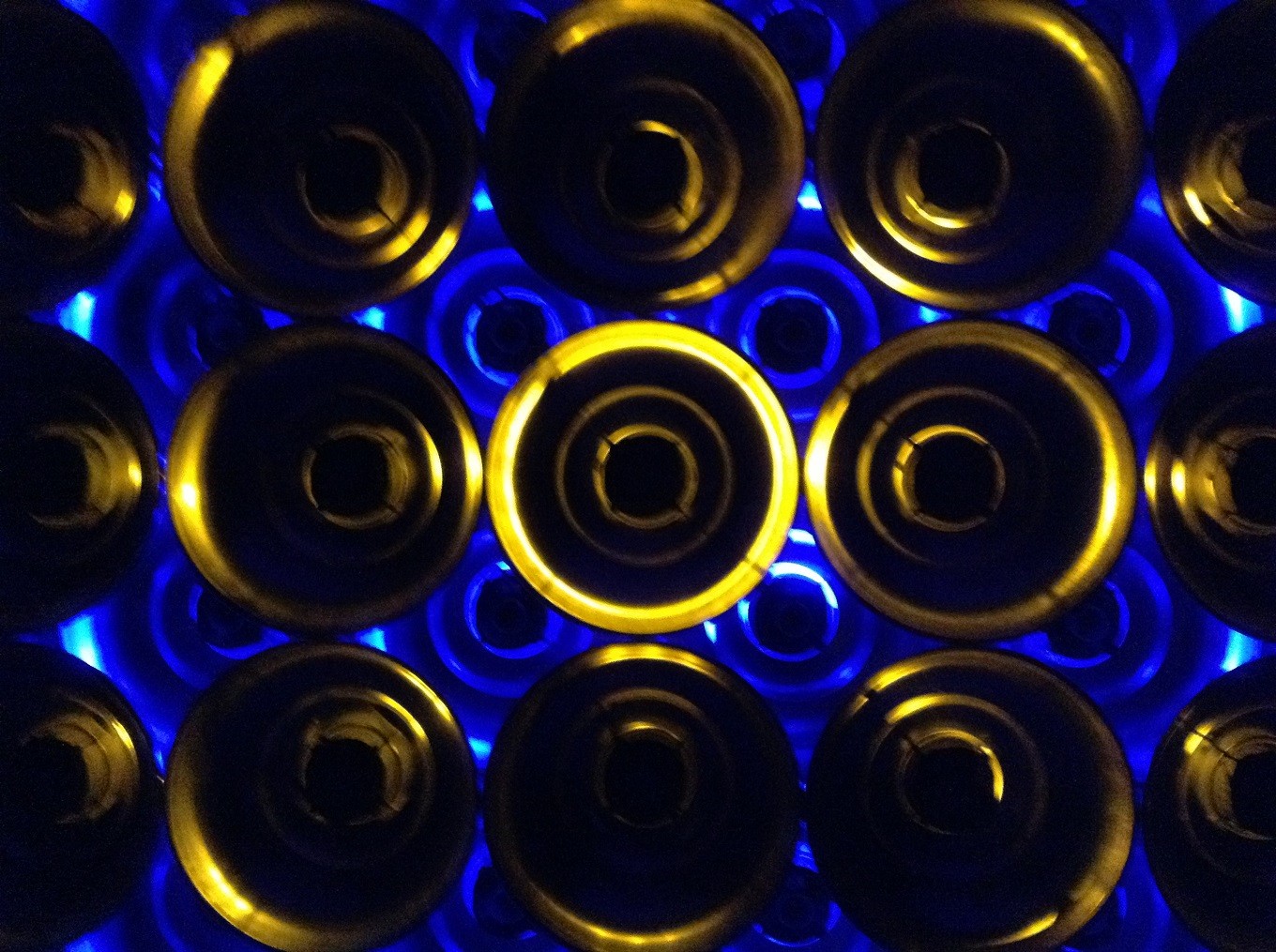 SONICreflection (2016) by Zulkifle Mahmod(JP/Rosa Connie Ladrido)
SONICreflection (2016) by Zulkifle Mahmod(JP/Rosa Connie Ladrido)
It represents an auditory ethnography of migrant workers in the city-state of Singapore in the spaces where they usually congregate: the Thais meet in Golden Mile complex; the Filipinos in Lucky Plaza, Orchard; the Indonesians in City Plaza, Paya Lebar; the Burmese in Peninsula Plaza; the Chinese in Geylang, and the Bengalis and the Nepalis in Little India. Zulkifle's work underscores the presence and contribution of Singapore's foreign workforce of 1.4 million as of June 2016, of which around 500,000 are construction workers and domestic workers.
One Has to Wander Through All the Outer Worlds to Reach the Innermost Shrine at the End, 2016 by Qiu Zhijie, China
Three massive sets of room-sized traditional Chinese scrolls of maps drawn with ink on paper present Qiu's investigation into the history of cartographic knowledge that links history, science, mythology, and philosophy. He has done similar mapping of the earth projects. His imaginative mapping mutates into an expansive fantasy universe and one wonders if it is simply the celestial projection of 21st century Chinese imperialism in the guise of fantasy maps?
A menagerie of Murano glass creatures and monsters imagined by the early cartographers when they reach a blank wall in their knowledge are spread on the floor.
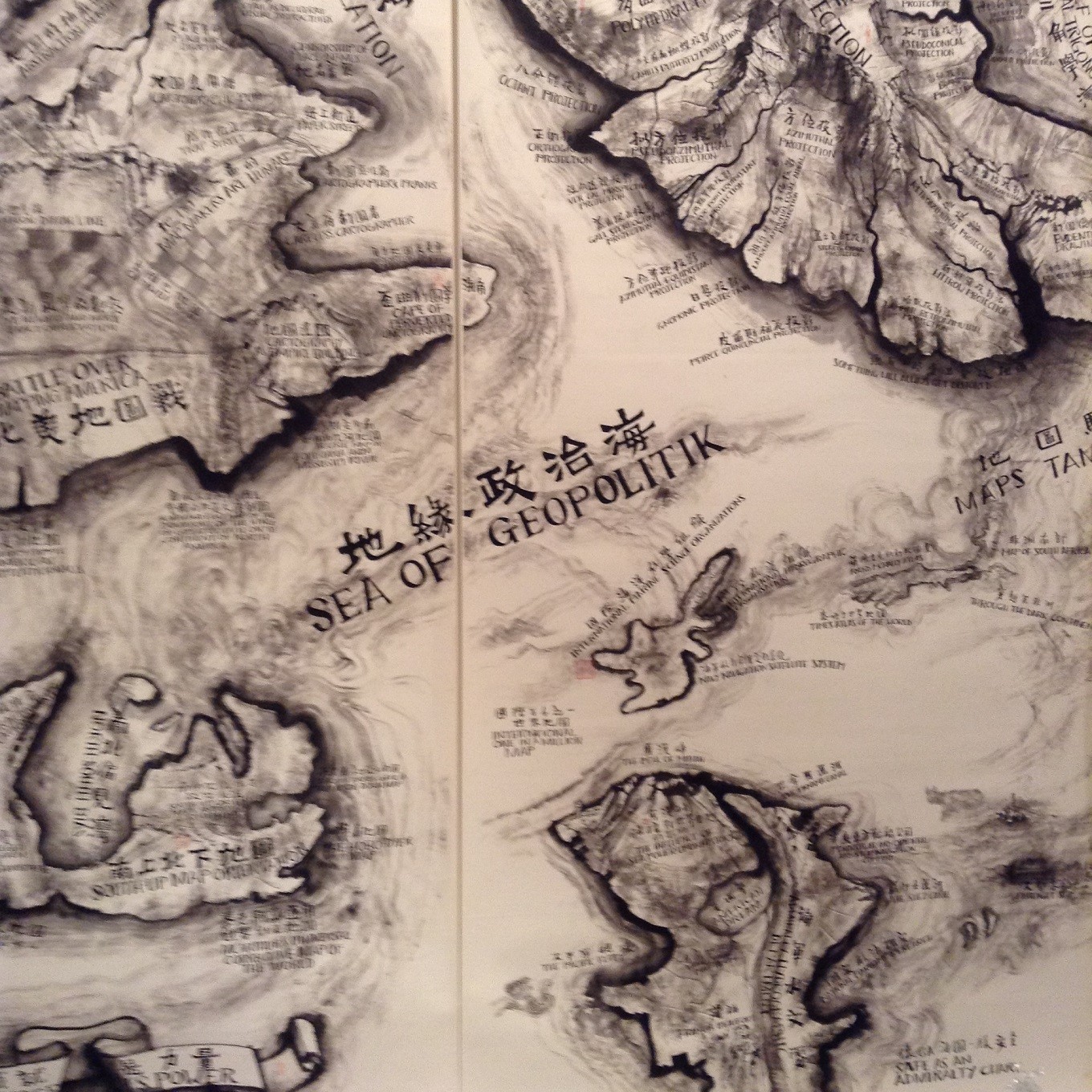 One Has to Wander Through All the Outer Worlds to Reach the Innermost Shrine at the End (2016) by Qiu Zhijie(JP/Rosa Connie Ladrido)
One Has to Wander Through All the Outer Worlds to Reach the Innermost Shrine at the End (2016) by Qiu Zhijie(JP/Rosa Connie Ladrido)
The largest map of 10 scrolls includes Sea of Geopolitik, Age of Discovery, Sea of Explorer, Gulf of Marco Polo, Maps Tamed the Unknown, Sea of the Old World, Sea of Sinbad and so on. The second map of three scrolls includes Sea of Biodiversity, Sea of Barbarian, Sea of the Tales on the Course, and the last map of three panels contains the Sea of Biodiversity, Sea of Mythology, Fantasy Maps, and Sea of Boundary Disputes that clearly shows islands in dispute with Vietnam and the Philippines such as the Paracels, Spratly, and Scarborough.
Soap Blocked, 2016 by Htein Lin, Myanmar
A cheap bar of pale yellow soap, an everyday material for washing away dirt and grime, has become a political weapon against Myanmar's socialist military regime.
A floor installation of a thousand bars of Shwe-Wah soap is shaped into a map of Myanmar. Each bar of soap is carved with a crouched figure, its bowed head supported by hands resting on folded knees and confined tightly inside four walls. The red color indicates the sites of existing prisons in Myanmar.
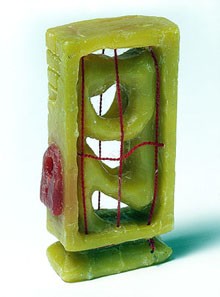 Htein's first soap bar smuggled out from prison.(International Red Cross and Red Crescent Museum/File)
Htein's first soap bar smuggled out from prison.(International Red Cross and Red Crescent Museum/File)
The installation replicates the first bar of soap with a hunched figure that the artist had carved and smuggled out of the country by a Red Cross representative in 1999 to decry the state of Myanmar's prisons. It was the only soap bar available and was also used as a precious item in Myanmar's black market under the military junta.
In prison for six-and-a-half years (1998-2004), Htein made art on scraps of cloth and managed to smuggle out around 300 paintings and prints on old prison uniforms and sculptures, without using any paint brush. In a 2013 interview with Art Radar, Htein muses: "Freedom is inside your mind."
***
A writer, copy editor and lecturer at the Chinese Studies Program, Ateneo de Manila University; nomad and does research on art, culture, and food history in the Philippines and beyond; a member of the Philippine PEN.
---------------
Interested to write for thejakartapost.com? We are looking for information and opinions from experts in a variety of fields or others with appropriate writing skills. The content must be original on the following topics: lifestyle ( beauty, fashion, food ), entertainment, science & technology, health, parenting, social media, travel, and sports.Send your piece to community@jakpost.com. For more information click here.

